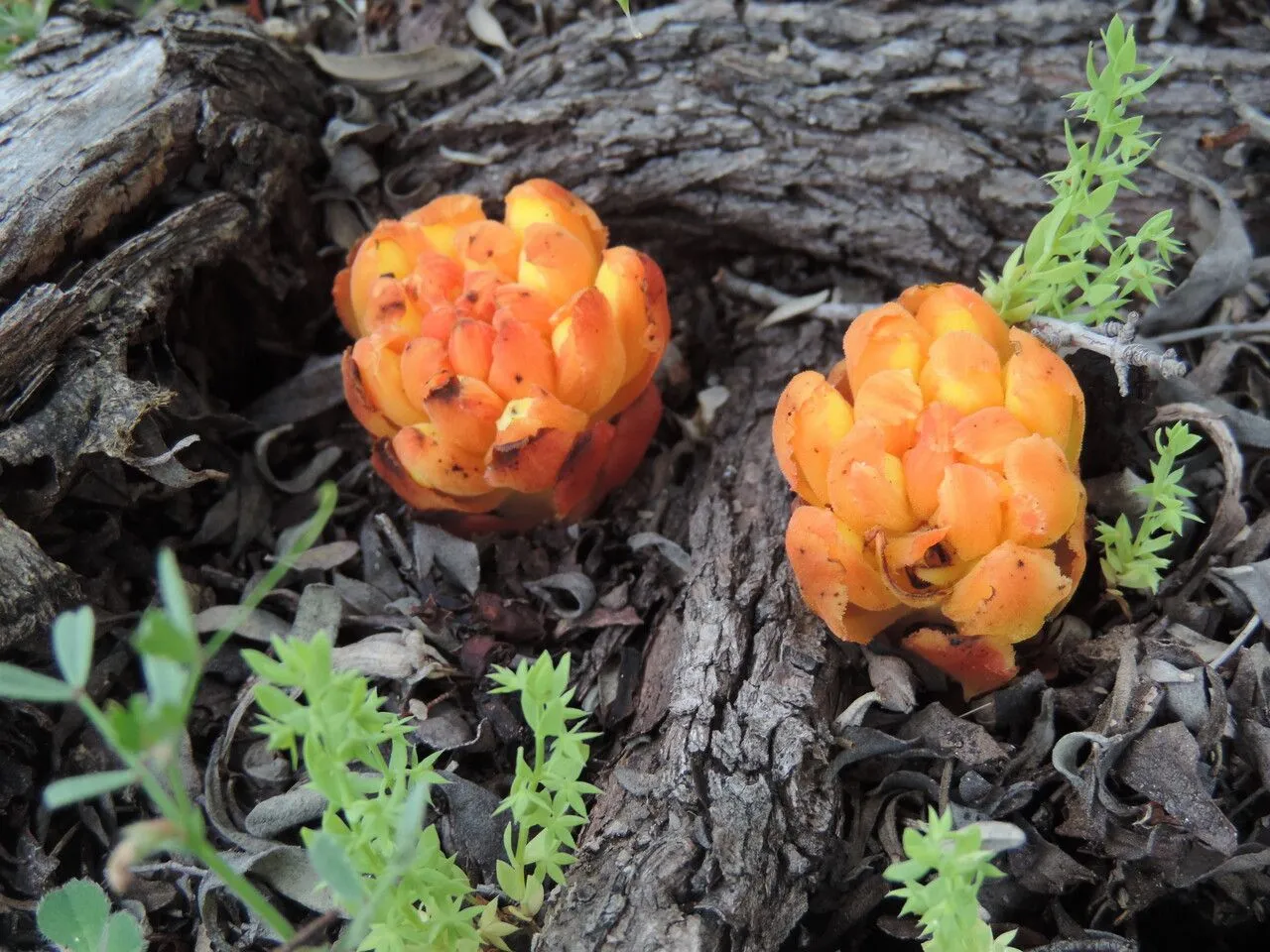
Author: (L.) L.
Bibliography: Gen. Pl. ed. 6: 566 (1764)
Year: 1764
Status: accepted
Rank: species
Genus: Cytinus
Vegetable: False
Observations: Medit.
Cytinus hypocistis, commonly known as Rockrose parasite, is a fascinating plant species well-known for its parasitic nature. Originally described in the 6th edition of “Genera Plantarum” in 1764, it is a plant that holds unique botanical importance and intriguing biological traits.
Belonging to the family Cytinaceae, Cytinus hypocistis exhibits a specialized relationship with its host plants, primarily targeting species within the Cistaceae family, which are commonly found across the Mediterranean region. These regions offer an ideal habitat for the Rockrose parasite due to favorable climatic and soil conditions, enabling its unique parasitic mechanisms to thrive.
The life cycle of Cytinus hypocistis is characterized by its complete dependence on its host for nutrients and survival since it lacks chlorophyll and cannot perform photosynthesis. The Rockrose parasite attaches itself to the roots of the host plant, extracting water and nutrients through specialized structures known as haustoria. This relationship often goes unnoticed until the parasite blooms, revealing its distinct and vibrant flowers.
The flowers of the Rockrose parasite are quite striking and can range in color from yellow to red. They emerge above the soil surface, sometimes in clusters, drawing the attention of pollinators and providing a stark contrast to the otherwise inconspicuous subterranean plant. The blooming of Cytinus hypocistis not only signals its presence but also contributes to the ecosystem by supporting pollinator species.
Given its unique ecological niche and parasitic lifestyle, Cytinus hypocistis has garnered interest from botanists and ecologists alike. Its existence underscores the complex interdependencies within plant communities and provides insight into the evolutionary adaptations that enable parasitic plants to survive and proliferate.
In conclusion, Cytinus hypocistis, or Rockrose parasite, is a noteworthy example of parasitism in the plant kingdom, showcasing remarkable adaptations and interactions with its host plants in the Mediterranean environment. Its presence is a testament to the intricate and often surprising relationships that define natural ecosystems.
En: Rockrose parasite, Yellow Cytinus
Ar: دغموس قابض
Bg: Жълт цитинус
Ca: Frare d’estepa
Hr: Šćipakčić
Nl: Gele hypocist
Fi: Keltakistuksenloisio
Fr: Cytinelle, Cytinet
Gl: Apóutega
De: Gelber Zistrosenwürger, Gemeiner Hypocist
He: רימונית הלוטם
It: Ipocisto comune
Pt: Pútegas-de-escamas-largas
Ru: Подладанник жёлтый
Es: Ipocisto comune
Taken Apr 24, 2021 by Rico García Antonio (cc-by-sa)
Taken May 1, 2022 by Tost Sedo (cc-by-sa)
Taken Mar 30, 2019 by Antonio Jesús Reina (cc-by-sa)
Taken Apr 3, 2018 by U De Jong (cc-by-sa)
Taken Apr 15, 2021 by Don Mondo (cc-by-sa)
Taken Apr 17, 2022 by Alba Abraham (cc-by-sa)
Taken May 18, 2020 by astico lolo (cc-by-sa)
Taken Apr 21, 2021 by Frédéric Gueydon (cc-by-sa)
Taken May 4, 2019 by Aad Kop (cc-by-sa)
Taken May 6, 2021 by Claude Ecochard (cc-by-sa)
Taken May 9, 2021 by sanchez chanito (cc-by-sa)
Taken Apr 11, 2021 by Schaub Eric (cc-by-sa)
Taken May 2, 2021 by ben dug (cc-by-sa)
Taken May 3, 2019 by Major Óssa (cc-by-sa)
Taken Apr 22, 2018 by Maria Domínguez (cc-by-sa)
Taken Apr 19, 2014 by Tela Botanica − Geneviève Botti (cc-by-sa)
Taken May 15, 2015 by Photoflora – Jean-Luc TASSET (©)
Taken Apr 5, 2022 by Fabio Biuzz (cc-by-sa)
Taken May 24, 2021 by Martin Marti (cc-by-sa)
Taken May 7, 2018 by Sergio costantini (cc-by-sa)
Taken Aug 22, 2022 by Ralf Staeck ralf.staeck (cc-by-sa)
Taken Feb 20, 2019 by Mattana Ivan (cc-by-sa)
Taken Apr 8, 2021 by José Narciso (cc-by-sa)
Taken Jan 6, 2022 by Margrit Ulbricht (cc-by-sa)
Taken Apr 15, 2007 by Photoflora – Benoit BOCK (©)
Taken Apr 15, 2007 by Photoflora – Benoit BOCK (©)
Taken Jun 10, 2018 by Tela Botanica − Marcel ETIENNE (cc-by-sa)
Taken May 15, 2015 by Photoflora – Benoit BOCK (©)
Taken Jan 1, 1970 by Photoflora – L’Abbé COSTE (©)
Ph maximum: 5.0
Ph minimum: 4.5
Light: 7
Atmospheric humidity: 3
Bloom months: [‘apr’, ‘may’, ‘jun’]
Soil nutriments: 3
Family: Myrtaceae Author: (F.Muell.) K.D.Hill & L.A.S.Johnson Bibliography: Telopea 6: 402 (1995) Year: 1995 Status:…
Family: Rubiaceae Author: Pierre ex A.Froehner Bibliography: Notizbl. Bot. Gart. Berlin-Dahlem 1: 237 (1897) Year:…
Family: Sapindaceae Author: Koidz. Bibliography: J. Coll. Sci. Imp. Univ. Tokyo 32(1): 38 (1911) Year:…
Family: Asteraceae Author: A.Gray Bibliography: Pacif. Railr. Rep.: 107 (1857) Year: 1857 Status: accepted Rank:…
Family: Fabaceae Author: Medik. Bibliography: Vorles. Churpfälz. Phys.-Ökon. Ges. 2: 398 (1787) Year: 1787 Status:…
Family: Aspleniaceae Author: (Cav.) Alston Bibliography: Bull. Misc. Inform. Kew 1932: 309 (1932) Year: 1932…